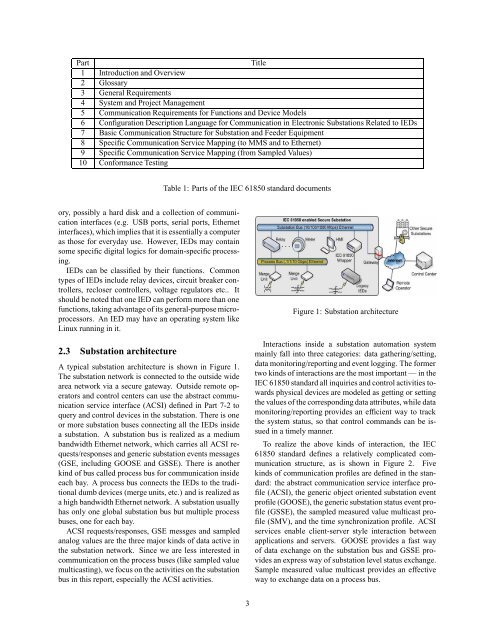Understanding and Simulating the IEC 61850 Standard - CiteSeerX
Understanding and Simulating the IEC 61850 Standard - CiteSeerX
Understanding and Simulating the IEC 61850 Standard - CiteSeerX
You also want an ePaper? Increase the reach of your titles
YUMPU automatically turns print PDFs into web optimized ePapers that Google loves.
Part<br />
Title<br />
1 Introduction <strong>and</strong> Overview<br />
2 Glossary<br />
3 General Requirements<br />
4 System <strong>and</strong> Project Management<br />
5 Communication Requirements for Functions <strong>and</strong> Device Models<br />
6 Configuration Description Language for Communication in Electronic Substations Related to IEDs<br />
7 Basic Communication Structure for Substation <strong>and</strong> Feeder Equipment<br />
8 Specific Communication Service Mapping (to MMS <strong>and</strong> to E<strong>the</strong>rnet)<br />
9 Specific Communication Service Mapping (from Sampled Values)<br />
10 Conformance Testing<br />
Table 1: Parts of <strong>the</strong> <strong>IEC</strong> <strong>61850</strong> st<strong>and</strong>ard documents<br />
ory, possibly a hard disk <strong>and</strong> a collection of communication<br />
interfaces (e.g. USB ports, serial ports, E<strong>the</strong>rnet<br />
interfaces), which implies that it is essentially a computer<br />
as those for everyday use. However, IEDs may contain<br />
some specific digital logics for domain-specific processing.<br />
IEDs can be classified by <strong>the</strong>ir functions. Common<br />
types of IEDs include relay devices, circuit breaker controllers,<br />
recloser controllers, voltage regulators etc.. It<br />
should be noted that one IED can perform more than one<br />
functions, taking advantage of its general-purpose microprocessors.<br />
An IED may have an operating system like<br />
Linux running in it.<br />
2.3 Substation architecture<br />
A typical substation architecture is shown in Figure 1.<br />
The substation network is connected to <strong>the</strong> outside wide<br />
area network via a secure gateway. Outside remote operators<br />
<strong>and</strong> control centers can use <strong>the</strong> abstract communication<br />
service interface (ACSI) defined in Part 7-2 to<br />
query <strong>and</strong> control devices in <strong>the</strong> substation. There is one<br />
or more substation buses connecting all <strong>the</strong> IEDs inside<br />
a substation. A substation bus is realized as a medium<br />
b<strong>and</strong>width E<strong>the</strong>rnet network, which carries all ACSI requests/responses<br />
<strong>and</strong> generic substation events messages<br />
(GSE, including GOOSE <strong>and</strong> GSSE). There is ano<strong>the</strong>r<br />
kind of bus called process bus for communication inside<br />
each bay. A process bus connects <strong>the</strong> IEDs to <strong>the</strong> traditional<br />
dumb devices (merge units, etc.) <strong>and</strong> is realized as<br />
a high b<strong>and</strong>width E<strong>the</strong>rnet network. A substation usually<br />
has only one global substation bus but multiple process<br />
buses, one for each bay.<br />
ACSI requests/responses, GSE messges <strong>and</strong> sampled<br />
analog values are <strong>the</strong> three major kinds of data active in<br />
<strong>the</strong> substation network. Since we are less interested in<br />
communication on <strong>the</strong> process buses (like sampled value<br />
multicasting), we focus on <strong>the</strong> activities on <strong>the</strong> substation<br />
bus in this report, especially <strong>the</strong> ACSI activities.<br />
Figure 1: Substation architecture<br />
Interactions inside a substation automation system<br />
mainly fall into three categories: data ga<strong>the</strong>ring/setting,<br />
data monitoring/reporting <strong>and</strong> event logging. The former<br />
two kinds of interactions are <strong>the</strong> most important — in <strong>the</strong><br />
<strong>IEC</strong> <strong>61850</strong> st<strong>and</strong>ard all inquiries <strong>and</strong> control activities towards<br />
physical devices are modeled as getting or setting<br />
<strong>the</strong> values of <strong>the</strong> corresponding data attributes, while data<br />
monitoring/reporting provides an efficient way to track<br />
<strong>the</strong> system status, so that control comm<strong>and</strong>s can be issued<br />
in a timely manner.<br />
To realize <strong>the</strong> above kinds of interaction, <strong>the</strong> <strong>IEC</strong><br />
<strong>61850</strong> st<strong>and</strong>ard defines a relatively complicated communication<br />
structure, as is shown in Figure 2. Five<br />
kinds of communication profiles are defined in <strong>the</strong> st<strong>and</strong>ard:<br />
<strong>the</strong> abstract communication service interface profile<br />
(ACSI), <strong>the</strong> generic object oriented substation event<br />
profile (GOOSE), <strong>the</strong> generic substation status event profile<br />
(GSSE), <strong>the</strong> sampled measured value multicast profile<br />
(SMV), <strong>and</strong> <strong>the</strong> time synchronization profile. ACSI<br />
services enable client-server style interaction between<br />
applications <strong>and</strong> servers. GOOSE provides a fast way<br />
of data exchange on <strong>the</strong> substation bus <strong>and</strong> GSSE provides<br />
an express way of substation level status exchange.<br />
Sample measured value multicast provides an effective<br />
way to exchange data on a process bus.<br />
3
















